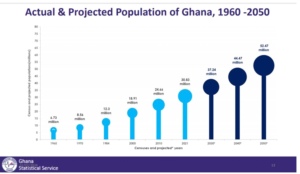By Juliet ETEFE
The country’s population is projected to increase to 37.24 million by 2030 and 52.47 million by 2050.
The 2021-2050 population projections report put together by the Ghana Statistical Service (GSS) revealed these figures, noting that the country’s projected total population in 2024 is 33,007,618 which is 1.07 times than that of 2021 (30,832,019).
Regional basis
It further indicated that the pattern of population growth within the 16 regions have seen significant changes between 1960 and 2021; Ashanti Region recorded the highest population size between 1960 and 2010 but was overturned in 2021 with Greater Accra Region recording the highest population size, and this pattern is projected to continue.
Greater Accra and Ashanti Regions are each projected to grow beyond 7.5 million people by 2050, meanwhile the population pressure on Greater Accra Region will deepen by 2030.
Three regions (Northern, North East and Savannah) experienced the highest growth and their respective populations are expected to double by 2050.

Working force
The country’s working age population (15-59 years) in 2021 was 17,949,834 and is projected to increase to 19,286,525 and 22,122,580 in 2024 and 2030 respectively.
Three regions, including North East (55.3%), Northern (54.9%) and Savannah (45.1%), are projected to have the highest increase in their working age population between 2021 and 2030.
Youth populations
The 15-24 years (6.26 million) population in 2021 is projected to increase by 662,229 persons to reach 6.92 million by 2030.
The 15-24 years population in Northern and Greater Accra Regions are each projected to increase by 1.2 times between 2021 and 2030.
Ashanti Region’s 15-24 years population, which was highest in 2021, is projected to experience the lowest growth toward 2030.
Sex ratio
Nationally, there are more females in Ghana than males; hence, for every 100 females there are 97 males – and this is projected to decrease to 96 for every 100 females by 2050.
Six of the 16 regions had more males for every 100 females in 2021 and was highest in Western North (105), followed by Western (103), Ahafo (102), Oti (102) Savannah (102) and Bono East at 101. By 2050, only four regions (Western North, Western, Ahafo and Oti) will remain male-dominated.
Also, the sex ratio was lowest in the Volta Region with 91 males for 100 females in 2021; and this is projected to decrease further to 90 males per 100 females in 2050.

School-going age
It is projected that there are currently 14,786,076 children of school-going age (4-24 years) in 2024, increasing from 14.12 million in 2021 and projected to increase further to 15.85 million in 2030.
Ashanti Region had the highest number of school-going age children (2.53 million) followed by Greater Accra (2.22 million) in 2021.
However, it is projected that Greater Accra will have the highest school-going age population of 2.67m in 2024 and is expected to reach 2.96m by 2030.
Urban projections
Urban population is projected to continue growing over the next decade (2021- 2030), from 56.7 percent in 2021 to 58.2 percent in 2024 – and further increase to 60.7 percent in 2030.
Nine of the 16 regions had more than half of their population living in rural localities in 2021, and it is projected that of the nine, seven regions – thus Volta, Oti, Western North, North East, Upper West, Savannah and Upper East – will continue to remain rural up to 2030.
Population structure
The country’s population structure has transitioned from a broad base to a youth bulge with the proportion of children 0-14 years decreasing from 44.6 percent in 1960 to 35.3 percent in 2021, while the 15-35 years population increased from 33.9 percent in 1960 to 38.2 percent in 2021.
The projected population structure is expected to change with the proportion of children further declining to reach 29.1 percent in 2050, while the proportion aged 60 years and older is expected to increase from 6.5 percent in 2021 to 10.8 percent by 2050.
The population aged 60 years and older has seen an increase from 1,991,736 in 2021 to 2,104,935 persons in 2024, and is estimated to rise to 2,485,951 by 2030.
Six regions – Northern, Savannah, North East, Western North, Bono East and Greater Accra – are projected to record a more than 50 percent increase in the number of older persons between 2021 and 2030.
Relevance of projections
Presenting the report in Accra, Deputy Government Statisticia, Dr. Faustina Frempong-Ainguah noted that the population projections offer insights into the future demographic landscape, informing policymakers, researchers and the public about potential changes.
She added that it is also critical for tracking the implementation of national, continental and global development goals.
The report also aimed at fostering collaborative as well as intersectoral approaches in planning development targets and designing policies for national development.










